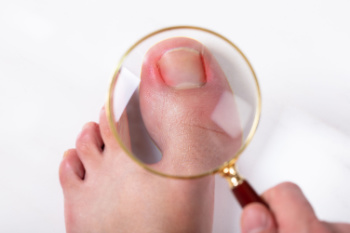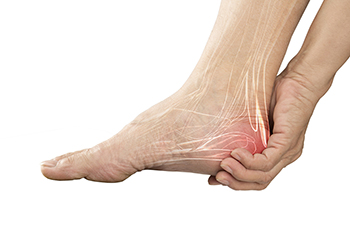Items filtered by date: December 2024
High Heels are Style with a Cost for Your Feet

High heels may look stylish, but they can take a toll on women’s feet and ankles. Wearing them shifts body weight forward, putting extra pressure on the toes and ball of the foot. This can lead to problems like bunions, ankle sprains from twisting, and even joint issues over time like osteoarthritis. High heels can also affect how the feet and ankles move, altering one's walking pattern, posture, and balance. These changes may extend to the knees and hips, causing pain and stiffness. Long-term wear increases the risk of musculoskeletal pain and balance issues, especially in uneven or slippery conditions. Limiting heel height, choosing supportive designs, and giving your feet regular breaks can help. If you experience ongoing pain or foot problems from wearing high heels, it is suggested that you consult a podiatrist for expert advice and treatment.
High heels have a history of causing foot and ankle problems. If you have any concerns about your feet or ankles, contact one our of podiatrists from The Foot and Ankle Specialists. Our doctors can provide the care you need to keep you pain-free and on your feet.
Effects of High Heels on the Feet
High heels are popular shoes among women because of their many styles and societal appeal. Despite this, high heels can still cause many health problems if worn too frequently.
Which Parts of My Body Will Be Affected by High Heels?
- Ankle Joints
- Achilles Tendon – May shorten and stiffen with prolonged wear
- Balls of the Feet
- Knees – Heels cause the knees to bend constantly, creating stress on them
- Back – They decrease the spine’s ability to absorb shock, which may lead to back pain. The vertebrae of the lower back may compress.
What Kinds of Foot Problems Can Develop from Wearing High Heels?
- Corns
- Calluses
- Hammertoe
- Bunions
- Morton’s Neuroma
- Plantar Fasciitis
How Can I Still Wear High Heels and Maintain Foot Health?
If you want to wear high heeled shoes, make sure that you are not wearing them every day, as this will help prevent long term physical problems. Try wearing thicker heels as opposed to stilettos to distribute weight more evenly across the feet. Always make sure you are wearing the proper shoes for the right occasion, such as sneakers for exercising. If you walk to work, try carrying your heels with you and changing into them once you arrive at work. Adding inserts to your heels can help cushion your feet and absorb shock. Full foot inserts or metatarsal pads are available.
If you have any questions, please feel free to contact our offices located in Houston and Deer Park, TX . We offer the newest diagnostic and treatment technologies for all your foot care needs.
Ankle Pain Caused by Arthritis

Ankle pain is often a symptom of arthritis, with osteoarthritis, rheumatoid arthritis, and gout being some of the leading causes. Osteoarthritis occurs when the protective cartilage in the ankle joint breaks down, causing pain, stiffness, and swelling. Rheumatoid arthritis, an autoimmune condition, causes inflammation in the joints, leading to pain and limited mobility. Gout, a type of arthritis caused by a buildup of uric acid crystals, often affects the ankle, causing sudden, intense pain and redness. Arthritis in the ankle can significantly impact daily activities, making walking or standing difficult. Over time, untreated arthritis can lead to joint deformities, further restricting movement. Treatment for arthritis-related ankle pain typically includes taking anti-inflammatory medications, targeted exercises, and lifestyle changes like weight management. In more severe cases, surgery may be necessary. A podiatrist can accurately diagnose the type of arthritis and create a personalized treatment plan to manage pain and improve mobility. If you are experiencing ankle pain from arthritis, it is suggested that you schedule an appointment with a podiatrist.
Ankle pain can have many different causes and the pain may potentially be serious. If you have ankle pain, consult with one our of podiatrists from The Foot and Ankle Specialists. Our doctors will assess your condition and provide you with quality foot and ankle treatment.
Ankle pain is any condition that causes pain in the ankle. Due to the fact that the ankle consists of tendons, muscles, bones, and ligaments, ankle pain can come from a number of different conditions.
Causes
The most common causes of ankle pain include:
- Types of arthritis (rheumatoid, osteoarthritis, and gout)
- Ankle sprains
- Broken ankles
- Achilles tendinitis
- Achilles tendon rupture
- Stress fractures
- Tarsal tunnel syndrome
- Plantar fasciitis
Symptoms
Symptoms of ankle injury vary based upon the condition. Pain may include general pain and discomfort, swelling, aching, redness, bruising, burning or stabbing sensations, and/or loss of sensation.
Diagnosis
Due to the wide variety of potential causes of ankle pain, podiatrists will utilize a number of different methods to properly diagnose ankle pain. This can include asking for personal and family medical histories and of any recent injuries. Further diagnosis may include sensation tests, a physical examination, and potentially x-rays or other imaging tests.
Treatment
Just as the range of causes varies widely, so do treatments. Some more common treatments are rest, ice packs, keeping pressure off the foot, orthotics and braces, medication for inflammation and pain, and surgery.
If you have any questions please feel free to contact our offices located in Houston and Deer Park, TX . We offer the newest diagnostic tools and technology to treat your foot and ankle needs.
Dealing With Ingrown Toenails

Ingrown toenails occur when the edges of a toenail grow into the surrounding skin, causing pain, redness, and swelling. In more severe cases, infection may develop, leading to pus or increased discomfort. Common causes include improper nail trimming, tight shoes, or trauma to the toe. Genetic factors can also play a role, as some people may have nails that are naturally curved. Treatment for an ingrown toenails often involves soaking the foot in warm water to reduce swelling and applying antibiotics if infection is present. In more persistent cases, a podiatrist may need to trim the nail, lift the edge, or remove part of the nail entirely. While home remedies can provide temporary relief, it is important to consult a podiatrist for safe and sterile professional care. They can ensure proper healing and help prevent future issues. If you are struggling with an ingrown toenail, it is suggested that you make an appointment with a podiatrist.
Ingrown toenails may initially present themselves as a minor discomfort, but they may progress into an infection in the skin without proper treatment. For more information about ingrown toenails, contact one our of podiatrists of The Foot and Ankle Specialists. Our doctors can provide the care you need to keep you pain-free and on your feet.
Ingrown Toenails
Ingrown toenails are caused when the corner or side of a toenail grows into the soft flesh surrounding it. They often result in redness, swelling, pain, and in some cases, infection. This condition typically affects the big toe and may recur if it is not treated properly.
Causes
- Improper toenail trimming
- Genetics
- Improper shoe fitting
- Injury from pedicures or nail picking
- Abnormal gait
- Poor hygiene
You are more likely to develop an ingrown toenail if you are obese, have diabetes, arthritis, or have any fungal infection in your nails. Additionally, people who have foot or toe deformities are at a higher risk of developing an ingrown toenail.
Symptoms
Some symptoms of ingrown toenails are redness, swelling, and pain. In rare cases, there may be a yellowish drainage coming from the nail.
Treatment
Ignoring an ingrown toenail can have serious complications. Infections of the nail border can progress to a deeper soft-tissue infection, which can then turn into a bone infection. You should always speak with your podiatrist if you suspect you have an ingrown toenail, especially if you have diabetes or poor circulation.
If you have any questions, please feel free to contact our offices located in Houston and Deer Park, TX . We offer the newest diagnostic and treatment technologies for all your foot care needs.
Recovery From Hammertoe Surgery

Hammertoe is a deformity that causes one or more toes to bend downward at the middle joint, resembling a hammer. This condition can result from muscle imbalance, wearing tight footwear, or injury, and it often leads to pain, corns, and difficulty walking. In mild cases, hammertoe can be managed with non-surgical treatments such as proper footwear and toe exercises. However, when the condition becomes severe, surgery may be required. The surgical procedure typically involves straightening the affected toe, removing excess bone, or realigning tendons to restore normal function. Recovery from hammertoe surgery can vary depending on the severity of the deformity and the type of procedure performed. Generally, patients are advised to rest, avoid putting weight on the foot, and wear special shoes during the healing process. Full recovery may take several weeks, but with proper care, the toe can regain proper alignment and function. If you have a painful hammertoe, it is suggested that you consult a podiatrist who can determine if surgery is a correct treatment option for you.
Foot surgery is sometimes necessary to treat a foot ailment. To learn more, contact one our of podiatrists of The Foot and Ankle Specialists. Our doctors will assist you with all of your foot and ankle needs.
When Is Surgery Necessary?
Foot and ankle surgery is generally reserved for cases in which less invasive, conservative procedures have failed to alleviate the problem. Some of the cases in which surgery may be necessary include:
- Removing foot deformities like bunions and bone spurs
- Severe arthritis that has caused bone issues
- Cosmetic reconstruction
What Types of Surgery Are There?
The type of surgery you receive will depend on the nature of the problem you have. Some of the possible surgeries include:
- Bunionectomy for painful bunions
- Surgical fusion for realignment of bones
- Neuropathy decompression surgery to treat nerve damage
Benefits of Surgery
Although surgery is usually a last resort, it can provide more complete pain relief compared to non-surgical methods and may allow you to finally resume full activity.
Surgical techniques have also become increasingly sophisticated. Techniques like endoscopic surgery allow for smaller incisions and faster recovery times.
If you have any questions, please feel free to contact our offices located in Houston and Deer Park, TX . We offer the newest diagnostic and treatment technologies for all your foot care needs.
Types and Causes of Heel Bursitis

Heel bursitis is an inflammation of fluid-filled sacs, known as bursae, located at the back of the heel. These bursae, the retrocalcaneal and calcaneal, act as cushions to reduce friction between the heel bone, Achilles tendon, and skin. Heel bursitis is often caused by repetitive activities like running or jumping, wearing poorly fitting footwear, or anatomical factors like heel spurs. Retrocalcaneal bursitis typically occurs between the Achilles tendon and heel bone, and may be associated with other heel issues, such as tendonitis. Calcaneal bursitis, located closer to the skin, is often linked to pressure from shoes, leading to redness and swelling at the back of the heel. Symptoms include pain, swelling, and difficulty walking. A podiatrist can diagnose the cause, assess the extent of the inflammation and provide effective treatments. Options include footwear modifications, custom orthotics, or other ways to relieve discomfort and prevent long-term complications. If you are suffering from heel pain, it is suggested that you schedule an appointment with a podiatrist for guidance.
Many people suffer from bouts of heel pain. For more information, contact one our of podiatrists of The Foot and Ankle Specialists. Our doctors can provide the care you need to keep you pain-free and on your feet.
Causes of Heel Pain
Heel pain is often associated with plantar fasciitis. The plantar fascia is a band of tissues that extends along the bottom of the foot. A rip or tear in this ligament can cause inflammation of the tissue.
Achilles tendonitis is another cause of heel pain. Inflammation of the Achilles tendon will cause pain from fractures and muscle tearing. Lack of flexibility is also another symptom.
Heel spurs are another cause of pain. When the tissues of the plantar fascia undergo a great deal of stress, it can lead to ligament separation from the heel bone, causing heel spurs.
Why Might Heel Pain Occur?
- Wearing ill-fitting shoes
- Wearing non-supportive shoes
- Weight change
- Excessive running
Treatments
Heel pain should be treated as soon as possible for immediate results. Keeping your feet in a stress-free environment will help. If you suffer from Achilles tendonitis or plantar fasciitis, applying ice will reduce the swelling. Stretching before an exercise like running will help the muscles. Using all these tips will help make heel pain a condition of the past.
If you have any questions, please feel free to contact our offices located in Houston and Deer Park, TX . We offer the newest diagnostic and treatment technologies for all your foot care needs.
